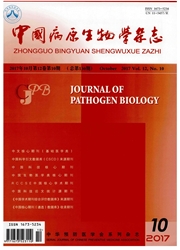

 中文摘要:
中文摘要:
目的 探讨Hain GenoType?MTBDR plus(Hain)和基因芯片技术检测结核分枝杆菌(MTB)异烟肼(INH)耐药性的应用价值。方法 随机选取289例结核患者的涂阳痰标本,各分成2份,分别进行罗氏培养和MTB DNA提取,提取的MTB DNA分别用Hain和基因芯片技术检测INH耐药性,罗氏培养阳性菌株做比例法药物敏感性试验。统计数据采用SPSS13.0软件分析。结果 MTB INH耐药性以比例法为金标准,Hain和基因芯片的灵敏度、特异度、准确度、阳性预测值(PPV)、阴性预测值(NPV)分别为82.56%、97.54%、93.08%、93.42%、92.96%和80.23%、98.03%、92.73%、94.52%、92.13%,一致性较高(Kappa值均〉0.75)。289例患者中,2种快速分子药敏方法检测MTB INH耐药性完全相同276例(208例为敏感,68例为耐药),符合率95.50%;8例Hain法INH耐药,其中1例KatG 315(AGC→ACC),2例KatG 315(AGC→ACA),5例inhA-8(T→C),而基因芯片法均为敏感;5例基因芯片法INH耐药,均为KatG 315(AGC→AAC),而Hain法均为敏感。结论 与比例法比较,检测MTB INH耐药性Hain和基因芯片法具有较高一致性,二者均可为临床提供快速、特异、较灵敏的INH耐药性检测结果。2种方法均适用于结核病早期快速的INH耐药性检测,但对INH敏感菌应结合临床其他指标综合分析。
 英文摘要:
英文摘要:
Objective To discuss the value of using the Hain GenoType MTBDR plus and a gene chip to detect Myco bacterium tuberculosis resistance to isoniazid (INH). Method Two hundred and eighty nine smear-positive specimens were randomly selected and divided into two groups. One was cultured on Lowenstein Jensen medium, and the other was used to extract M. tuberculosis DNA. The extracted DNA was used to detect the resistance of M. tuberculosis to INH u- sing the GenoType MTBDRplus and a gene chip. Strains cultured on Lowenstein-Jensen medium were subjected to a drug sensitivity test using the proportion method. Statistical data were analyzed using SPSS13.0. Results Resistance to INH was judged in accordance with the conventional proportion method. The GenoType MTBDRpIus had a sensitivity of 82. 56%, a specificity of 97.54%, an accuracy of 93.08%, a positive predictive value (PPV) of 93.42%, and a negative predictive value (NPV) of 92.96%. The gene chip had a sensitivity of 80.23%, a specificity of 98.03%, an accuracy of 92. 73%, a PPV of 94.52%, and an NPV of 92.13%. The GenoType MTBDRplus and the gene chip had a high degree of concordance (kappa〉0.75). The two rapid detection techniques yielded the same results for 276 of the 289 samples (208 were sensitive and 68 were resistant) with a consistency of 95.50%. In 8 samples that the GenoType MTBDRplus indica- ted were resistant to INH, 1 had a strain with the KatG 315 (AGC→ACC) mutation, 2 had a strain with the KatG 315 (AGC→ACA) mutation, and 5 had a strain with the inhA-8 (T→C) mutation. The gene chip was sensitive at detecting all of these samples. In 5 samples that the indicated were resistant to INH, all 5 had a strain with the KatG 315 (AGC→AAC) mutation. The GenoType MTBDRplus was sensitive at detecting all of these samples. Conclusion Compared to the proportion method, the GenoType MTBDRplus and a gene chip are highly consistent in detecting resistance to INH. The two rapid detection techniques both rapidly, specifically
 同期刊论文项目
同期刊论文项目
 同项目期刊论文
同项目期刊论文
 期刊信息
期刊信息
